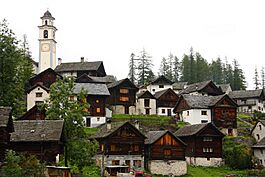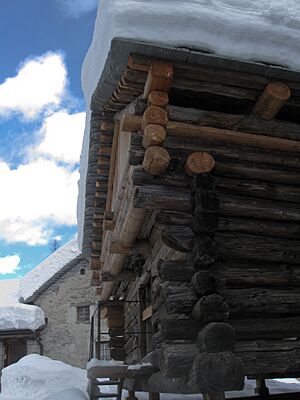Bosco/Gurin facts for kids
Quick facts for kids
Bosco/Gurin
|
||
|---|---|---|
 |
||
|
||
| Country | Switzerland | |
| Canton | Ticino | |
| District | Vallemaggia | |
| Area | ||
| • Total | 22.01 km2 (8.50 sq mi) | |
| Elevation | 1,504 m (4,934 ft) | |
| Population
(Dec 2020 )
|
||
| • Total | 52 | |
| • Density | 2.363/km2 (6.12/sq mi) | |
| Postal code |
6685
|
|
| Surrounded by | Campo, Cerentino, Cevio, Formazza (IT-VB), Premia (IT-VB) | |
Bosco/Gurin is a small town in the canton of Ticino in Switzerland. It's located in the Vallemaggia district, close to the border with Italy. Even though most of Ticino speaks Italian, Bosco/Gurin is special because it has historically been a German-speaking village. It's the only place in Ticino where German is also an official language.
Contents
History of Bosco/Gurin
Bosco/Gurin was first mentioned way back in 1244. For a long time, until 1934, it was known as Bosco-Vallemaggia, and in German, it was called Gurin.
The Walser People
The village was started by people called the Walser in the 13th century. The first settlers arrived around 1244. The Walser were a group of people who moved from the Val Formazza area around 1240. They were invited by the rulers of Lombardy and Locarno because they needed strong fighters.
Over time, the Walser people in Bosco/Gurin became quite isolated. They had more contact with people from Val Formazza or Valais than with the rest of Ticino. This isolation helped them keep their unique way of life and traditions.
Village Life and Changes
The local church, dedicated to St. James and St. Christopher, was built in 1253. It was later made bigger in the 15th and 16th centuries.
For many centuries, people in Bosco/Gurin made their living from farming and raising animals. They grew potatoes, rye, and hemp. In winter, they would make wooden tools and spin linen, hemp, and wool.
In the 20th century, many people moved away from the village. In 1936, a local museum was opened to preserve the village's history. The population dropped from 382 people in 1850 to just 72 by 2004.
Today, the special Walser German language is slowly being replaced by Italian. Most people in the village now speak Italian.
The "Soul-Beam" Custom
An interesting old custom in Bosco/Gurin was building houses with a "Seelabalga," which means "soul-beam." This was a small wooden door that covered a round hole in the wall. People would open it to let the soul of someone who had passed away leave the house.
Geography of Bosco/Gurin
Bosco/Gurin is the highest town in Ticino, sitting at an elevation of 1,504 meters (about 4,934 feet).
The town covers an area of about 22 square kilometers (8.5 square miles). A small part of this land, about 3.1%, is used for farming. Forests cover about 27.9% of the area. Buildings and roads take up a small portion, around 0.9%. Rivers and lakes make up about 1.3% of the land. The largest part, about 42.1%, is unproductive land, meaning it's too rocky or has too little vegetation to be used for farming or building.
Coat of Arms
The coat of arms for Bosco/Gurin shows a blue shield with a red lion standing on its hind legs. The lion holds a red letter "B."
People and Languages
Bosco/Gurin has a small population of 52 people.
Languages Spoken
The languages spoken in Bosco/Gurin have changed over time:
| Year | 1970 | 1980 | 1990 | 2000 |
|---|---|---|---|---|
| German | 95 (81.9%) | 61 (93.8%) | 35 (60.3%) | 23 (32.4%) |
| Italian | 18 (15.5%) | 3 (4.6%) | 20 (34.5%) | 37 (52.1%) |
| Inhabitants | 116 (100%) | 65 (100%) | 58 (100%) | 71 (100%) |
As you can see from the table, in 1970, most people spoke German. By 2000, Italian became the most common language, with German being the second most spoken. A small number of people also spoke Romansh.
Population Changes Over Time
The number of people living in Bosco/Gurin has changed a lot throughout history. Here's how the population has looked:

Important Heritage Sites
The entire village of Bosco/Gurin is considered an important heritage site because it has many old and historic buildings. One special building, called the Walserhaus, is a traditional Walser style house. It's listed as a very important cultural property for Switzerland.
Economy
Tourism is a big part of Bosco/Gurin's economy, especially during the winter months when people come to ski.
In 2005, there were 12 people working in farming and related businesses. Another 12 people worked in construction. The largest number of people, 27, worked in the service industry, which includes things like hotels and restaurants.
In 2009, there was one hotel in Bosco/Gurin.
Religion
According to a survey in 2000, most people in Bosco/Gurin, about 85.9%, were Roman Catholic. A smaller number, about 2.8%, belonged to the Swiss Reformed Church.
Education
In Bosco/Gurin, about 39.4% of the people have finished high school, and 7% have gone on to higher education, like a university.
In 2009, there were 5 students in Bosco/Gurin.
- 1 child was in kindergarten.
- 1 student was in primary school.
- 1 student was in middle school.
- 2 students were in vocational training, learning skills for a job.
In 2000, 9 students from Bosco/Gurin went to schools outside the town.
See also
 In Spanish: Bosco-Gurin para niños
In Spanish: Bosco-Gurin para niños







